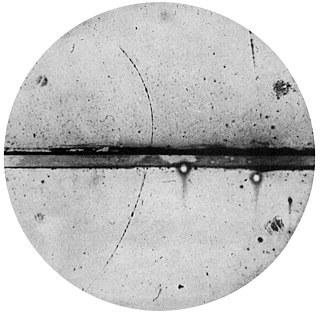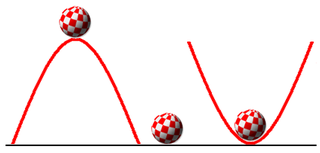Related Research Articles

In modern physics, antimatter is defined as matter composed of the antiparticles of the corresponding particles in "ordinary" matter, and can be thought of as matter with reversed charge, parity, and time, known as CPT reversal. Antimatter occurs in natural processes like cosmic ray collisions and some types of radioactive decay, but only a tiny fraction of these have successfully been bound together in experiments to form antiatoms. Minuscule numbers of antiparticles can be generated at particle accelerators; however, total artificial production has been only a few nanograms. No macroscopic amount of antimatter has ever been assembled due to the extreme cost and difficulty of production and handling. Nonetheless, antimatter is an essential component of widely-available applications related to beta decay, such as positron emission tomography, radiation therapy, and industrial imaging.

The stability of a plasma is an important consideration in the study of plasma physics. When a system containing a plasma is at equilibrium, it is possible for certain parts of the plasma to be disturbed by small perturbative forces acting on it. The stability of the system determines if the perturbations will grow, oscillate, or be damped out.
The Antihydrogen Trap (ATRAP) collaboration at the Antiproton Decelerator facility at CERN, Geneva, is responsible for the AD-2 experiment. It is a continuation of the TRAP collaboration, which started taking data for the TRAP experiment in 1985. The TRAP experiment pioneered cold antiprotons, cold positrons, and first made the ingredients of cold antihydrogen to interact. Later ATRAP members pioneered accurate hydrogen spectroscopy and observed the first hot antihydrogen atoms.
A shape resonance is a metastable state in which an electron is trapped due to the shape of a potential barrier. Altunata describes a state as being a shape resonance if, "the internal state of the system remains unchanged upon disintegration of the quasi-bound level." A more general discussion of resonances and their taxonomies in molecular system can be found in the review article by Schulz,; for the discovery of the Fano resonance line-shape and for the Majorana pioneering work in this field by Antonio Bianconi; and for a mathematical review by Combes et al.
The Institute for Laser Science is a department of the University of Electro Communications, located near Tokyo, Japan.

Liu Chen is an American theoretical physicist who has made original contributions to many aspects of plasma physics. He is known for the discoveries of kinetic Alfven waves, toroidal Alfven eigenmodes, and energetic particle modes; the theories of geomagnetic pulsations, Alfven wave heating, and fishbone oscillations, and the first formulation of nonlinear gyrokinetic equations. Chen retired from University of California, Irvine (UCI) in 2012, assuming the title professor emeritus of physics and astronomy.
Double ionization is a process of formation of doubly charged ions when laser radiation is exerted on neutral atoms or molecules. Double ionization is usually less probable than single-electron ionization. Two types of double ionization are distinguished: sequential and non-sequential.

Ratko Janev was a Yugoslav and Serbian atomic physicist and Macedonian academician.
A non-neutral plasma is a plasma whose net charge creates an electric field large enough to play an important or even dominant role in the plasma dynamics. The simplest non-neutral plasmas are plasmas consisting of a single charge species. Examples of single species non-neutral plasmas that have been created in laboratory experiments are plasmas consisting entirely of electrons, pure ion plasmas, positron plasmas, and antiproton plasmas.
AEgIS, AD-6, is an experiment at the Antiproton Decelerator facility at CERN. Its primary goal is to measure directly the effect of Earth's gravitational field on antihydrogen atoms with significant precision. Indirect bounds that assume the validity of, for example, the universality of free fall, the Weak Equivalence Principle or CPT symmetry also in the case of antimatter constrain an anomalous gravitational behavior to a level where only precision measurements can provide answers. Vice versa, antimatter experiments with sufficient precision are essential to validate these fundamental assumptions. AEgIS was originally proposed in 2007. Construction of the main apparatus was completed in 2012. Since 2014, two laser systems with tunable wavelengths and synchronized to the nanosecond for specific atomic excitation have been successfully commissioned.
Jose A. Boedo is a Spanish plasma physicist and a researcher at University of California, San Diego. He is an Elected Fellow of the American Physical Society, which was awarded in 2016 for "his ground-breaking contributions to the studies of plasma drifts and intermittent plasma transport in the peripheral region of tokamaks".
High Harmonic Generation (HHG) is a non-perturbative and extremely nonlinear optical process taking place when a highly intense ultrashort laser pulse undergoes an interaction with a nonlinear media. A typical high order harmonic spectra contains frequency combs separated by twice the laser frequency. HHG is an excellent table top source of highly coherent extreme ultraviolet and soft X-ray laser pulses.

The buffer-gas trap (BGT) is a device used to accumulate positrons efficiently while minimizing positron loss due to annihilation, which occurs when an electron and positron collide and the energy is converted to gamma rays. The BGT is used for a variety of research applications, particularly those that benefit from specially tailored positron gases, plasmas and/or pulsed beams. Examples include use of the BGT to create antihydrogen and the positronium molecule.
Guy Laval is a French physicist, professor at the École polytechnique and member of the French Academy of Sciences.
Nathaniel Joseph Fisch is an American plasma physicist known for pioneering the excitation of electric currents in plasmas using electromagnetic waves, which was then used in tokamak experiments. This contributed to an increased understanding of plasma wave–particle interactions in the field for which he was awarded the James Clerk Maxwell Prize for Plasma Physics in 2005 and the Hannes Alfvén Prize in 2015.

Akira Hasegawa is a Japanese theoretical physicist and engineer who has worked in the U.S. and Japan. He is known for his work in the derivation of the Hasegawa–Mima equation, which describes fundamental plasma turbulence and the consequent generation of zonal flow that controls plasma diffusion. Hasegawa also made the discovery of optical solitons in glass fibers, a concept that is essential for high speed optical communications.

John Holmes Malmberg was an American plasma physicist and a professor at the University of California, San Diego. He was known for making the first experimental measurements of Landau damping of plasma waves in 1964, as well as for his research on non-neutral plasmas and the development of the Penning–Malmberg trap.
Keith Howard Burrell is an American plasma physicist.

The Penning–Malmberg trap, named after Frans Penning and John Malmberg, is an electromagnetic device used to confine large numbers of charged particles of a single sign of charge. Much interest in Penning–Malmberg (PM) traps arises from the fact that if the density of particles is large and the temperature is low, the gas will become a single-component plasma. While confinement of electrically neutral plasmas is generally difficult, single-species plasmas can be confined for long times in PM traps. They are the method of choice to study a variety of plasma phenomena. They are also widely used to confine antiparticles such as positrons and antiprotons for use in studies of the properties of antimatter and interactions of antiparticles with matter.
Patrick Henry Diamond is an American theoretical plasma physicist. He is currently a professor at the University of California, San Diego, and a director of the Fusion Theory Institute at the National Fusion Research Institute in Daejeon, South Korea, where the KSTAR Tokamak is operated.
References
- ↑ Gale Group. (2004). American men & women of science. Gale. OCLC 1082415302.
- ↑ Sullivan, J. P.; Marler, J. P.; Gilbert, S. J.; Buckman, S. J.; Surko, C. M. (2001). "Excitation of Electronic States of Ar, ${H}_{2}$, and ${N}_{2}$ by Positron Impact". Physical Review Letters. 87 (7): 073201. doi:10.1103/PhysRevLett.87.073201. PMID 11497889.
- ↑ Surko, C. M.; Reif, F. (1968). "Investigation of a New Kind of Energetic Neutral Excitation in Superfluid Helium". Physical Review. 175 (1): 229–241. doi:10.1103/PhysRev.175.229.
- ↑ Sullivan, James P.; Gilbert, Steven J.; Buckman, Stephen J.; Surko, Clifford M. (2001). "Search for resonances in the scattering of low-energy positrons from atoms and molecules". Journal of Physics B: Atomic, Molecular and Optical Physics. 34 (15): L467–L474. doi:10.1088/0953-4075/34/15/102. ISSN 0953-4075.
- ↑ Surko, Clifford M. Gianturco, Franco A., 1938- (2002). New directions in antimatter chemistry and physics. Kluwer Academic. OCLC 839947424.
{{cite book}}: CS1 maint: multiple names: authors list (link) - ↑ Surko, Clifford M. (2007). "Atomic physics: A whiff of antimatter soup". Nature. 449 (7159): 153–156. doi: 10.1038/449153a . PMID 17851505.
- ↑ Surko, C. M.; Leventhal, M.; Passner, A.; Wysocki, F. J. (1988). "A positron plasma in the laboratory—how and why". AIP Conference Proceedings. 175 (1): 75–90. doi:10.1063/1.37614. ISSN 0094-243X.
- ↑ Gribakin, G. F.; Young, J. A.; Surko, C. M. (2010). "Positron-molecule interactions: Resonant attachment, annihilation, and bound states" (PDF). Reviews of Modern Physics. 82 (3): 2557–2607. doi:10.1103/revmodphys.82.2557. ISSN 0034-6861.
- ↑ Lehrer, Erica (August 21, 2019). "Frederick Reif". Physics Today. doi:10.1063/pt.6.4o.20190821a . Retrieved June 17, 2022.
- ↑ "UC San Diego | Faculty Profile". www-physics.ucsd.edu. Retrieved February 28, 2020.
- ↑ "2014 James Clerk Maxwell Prize for Plasma Physics Recipient". American Physical Society. Retrieved February 28, 2020.